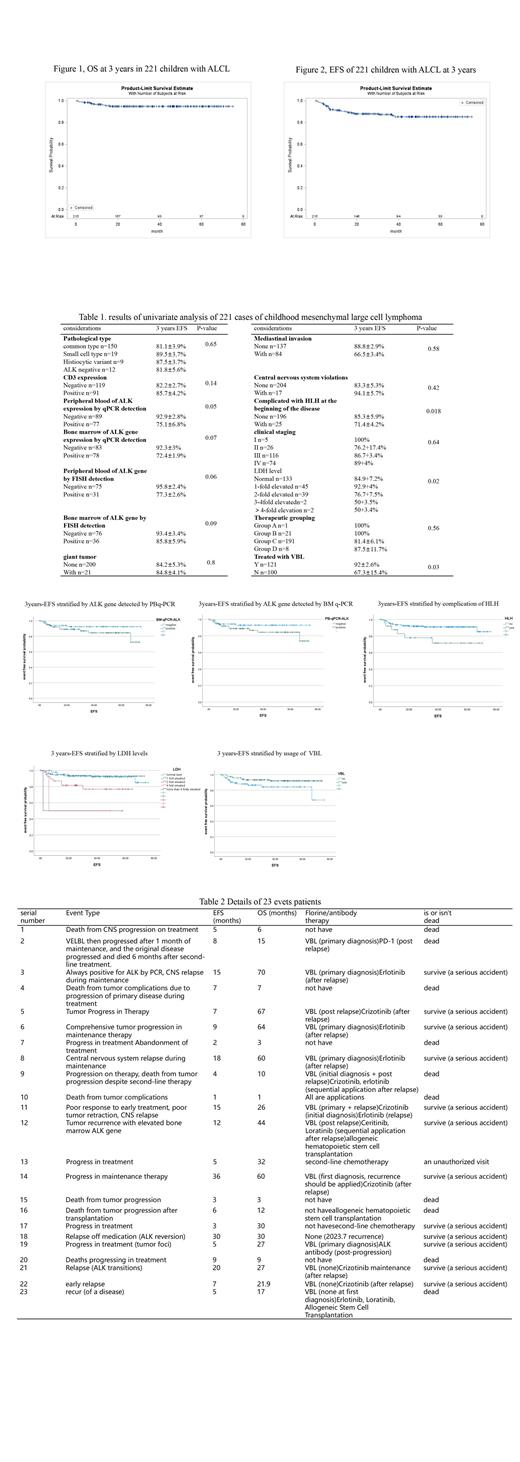Objective: To investigate the clinical-pathology characteristics, risk factors, necessary for VBL maintenance therapy,through summarize the clinical data of 221 cases of pediatric Anaplastic Large Cell Lymphoma (ALCL), treated with CNCL-ALCL-2017 witch is modify from BFM-ALCL-99 (±vincristine maintenance therapy) in China Net Childhood Lymphoma (CNCL).
Methods: Data were collected on 221 children with ALCL enrolled from CNCL at time between April 2017 to March 2023, including: numbers of cases enrolled in each single center, gender and age at the time of initial diagnosis, the first initial symptom, a delay diagnosis, the misdiagnosis disease , the site of involvement, the level of blood uric acid, the level of blood lactate dehydrogenase, the bone marrow and CNS status, tumor complication, complicated with HLH, staging and treatment subgroups, pathological subtypes, CD3 expression in tumor tissue, bone marrow and peripheral blood ALK gene expression at initial diagnosis (qPCR + FISH), and treatment outcomes, treatment strategy(vincristine maintenance or not), time from initial diagnose to relapse, second-line treatment regimen after relapse, and treatment outcomes after relapsed. Statistical analysis was conducted using SPSS 21.0 software.
Results: 221 cases were from 22 hospitals in China. Male = 144 cases, female = 71 cases, age range from 1-16 years (median age 8.9 years), duration from initial symptoms onset to diagnosis was 0.3-11 months (median time 1.0 months), delayed diagnosis was present in 51(23%) children (45 children were misdiagnosed with infectious diseases). Pathological subtypes were: common sub type = 150(67.8%), small cell sub type = 19(8.5%), histiocytic variant subtype = 9(4%), ALK negative subtype = 12(5.4%).others = 31(14%). CD3 expression in tumor: negative = 119, positive = 91. ALK positive by qPCR in peripheral blood at the time of the initial diagnosis = 77, ALK positive by qPCR in bone marrow = 78, bulky disease= 21, mediastinal invasion = 84, CNS invasion = 17, skin invasion = 32. tumor related HLH = 25, normal LDH level at initial diagnosis = 133, 1-fold elevated = 45, 2-3-fold elevated = 39, 4-fold elevated = 2, >4-fold elevated = 2, stage I = 5, stage II = 24, stage III = 70, stage IV = 120 , leukemic stage = 2 . Grouping: group A = 1, group B = 21, group C = 191, group D = 8. Vincristine maintenance = 121. Median follow-up time was 35.4 months (0.5-74.9 months), OS at 3 years = 95.1±1.5% (95% CI = 90%-97.3%, Fig. 1), EFS at 3 years = 84.7±4.5% (95% CI = 79%-89.9%, Fig. 2), and there were a total of 23 patients with events, median time was7 months. There were 10 patients died, 5 of them quit to the treatment, median time was 5 months, and 13 patients who had an event but still alive after second line treatment. Univariate results of the 3 years EFS are detailed in Table 1, with statistically significant including (<0.05): tumor related HLH before treatment, LDH levels higher than 4 times normal and MDD positive at the beginning of the disease, and treated without VBL. The event patients are 23 cases ,the detailed in Table 2, which showed that the earlier the event occurs, the higher the mortality rate.
Conclusion:Pediatric ALCL in China is mostly found in school-age boys, and it is easy to be diagnosed as infectious diseases at the time of initial diagnosis due to high fever and elevated CRP. 87% of patients were diagnosed as late stage or high-risk group. The application of the CNCL-ALCL-2017 protocol showed a 3-year OS 84.7% and 3-year EFS 95.1%, indicating that the efficacy was significantly better than that of various centers before the multi center cooperation. The overall survival time is significantly better than the event free survival time, indicating that most patients with progression and recurrence still have a chance of re remission after second line treatment. Adverse prognostic factors include a significant increase in LDH levels at initial diagnosis, initial onset of HLH, positive MDD before treatment, and no use of vinblastine maintenance therapy. Recurrent children: The median recurrence time is 7 months, and the prognosis of early progression and recurrence is worse than that of late recurrence.
Key words: Anaplastic large cell lymphoma, Pediatric, Clinical-pathology features, Prognosis
Disclosures
No relevant conflicts of interest to declare.


This feature is available to Subscribers Only
Sign In or Create an Account Close Modal